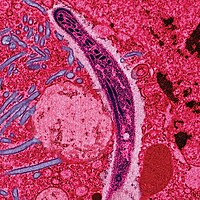
Photo from wikipedia
Abstract To explore the values of C-reactive protein (CRP) and procalcitonin (PCT) in identifying infection and disease activity in systemic lupus erythematosus (SLE) patients. Patients with SLE and infection from… Click to show full abstract
Abstract To explore the values of C-reactive protein (CRP) and procalcitonin (PCT) in identifying infection and disease activity in systemic lupus erythematosus (SLE) patients. Patients with SLE and infection from April 2015 to January 2018 were included in this study. We compared the clinical characteristics and biomarkers between different groups and calculated the receiver operating characteristic curve, sensitivity, and specificity of the corresponding biomarkers. Logistic regression analysis was performed on the variables exhibiting significant differences in univariate analysis. A total of 177 SLE patients were retrospectively analyzed. The patients were divided into noninfected-inactive group, noninfected-active group, infected-inactive group, and infected-active group. CRP level of infected-inactive group was significantly higher than noninfected-inactive group (P < .05), but not significantly in infected-active group than noninfected-active group (P > .05). Multivariate analysis showed that CRP (>24.0 mg/L) was the only independent risk factor for SLE infection (odds ratio, OR = 2.896, P = .032). PCT level of infected-active group was significantly higher than infected-inactive group (P < .05), but not significantly in noninfected-active group than noninfected-inactive group (P > .05). SLE active group had shorter disease course, lower infection rate, higher PCT level, and lower platelet count (PLT). Multivariate logistic analysis showed that PCT (>0.048 ng/mL) and PLT (<150 × 109/L) were independent risk factors for SLE activity (OR = 3.498 and 4.391, P = .011 and 0.009), and disease course (>96 months) was independent protective factor (OR = 0.169, P < .001). The area under the curve of the logistic model was significantly larger than any single variable (all P < .05). CRP is the only effective marker for diagnosing infection in SLE patients. Moreover, PCT helps predict SLE activity.
Journal Title: Medicine
Year Published: 2019
Link to full text (if available)
Share on Social Media: Sign Up to like & get
recommendations!